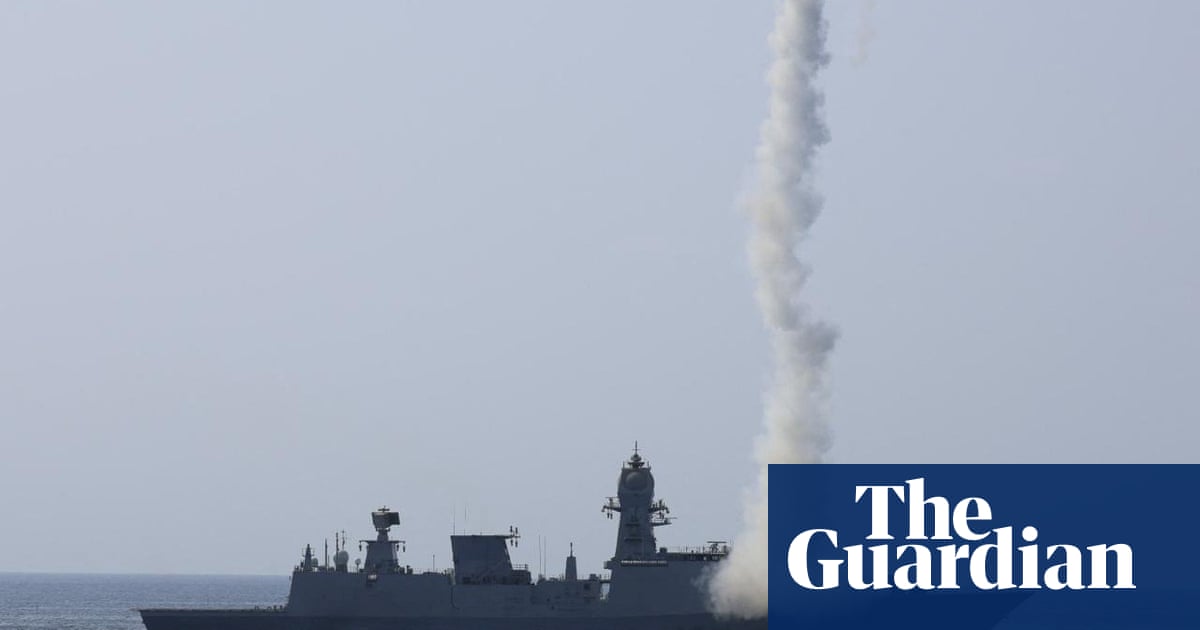India’s navy test-fired missiles on Sunday, showcasing its ability to carry out “long-range, precision offensive” strikes, as tensions with Pakistan rise afterlast week’s terrorist attackin Indian-administered Kashmir that killed 26 civilians.
“Indian Navy ships undertook successful multiple anti-ship firings to re-validate and demonstrate readiness of platforms, systems, and crew for long-range precision offensive strike,” the navy posted on X, as the prime minister,Narendra Modi, promised a “harsh response” to the attack at a tourist site, the deadliest against civilians in Kashmir in 25 years.
Modi, who has been briefing world leaders to build support for India’s position, told listeners in his monthly radio address that every Indian’s blood was “on the boil”. His words echoed previous statements where he vowed to hunt down the attackers “to the ends of the Earth” and turn terrorist hideouts “into dust”.
The missiles launched are designed for powerful, long-range, high-precision strikes. The navy stressed the importance of the drills in maintaining “operational” readiness as military rhetoric intensified on both sides.
Pakistan’s railway minister, Hanif Abbasi, warned over the weekend that the country’s nuclear arsenal of more than 130 missiles was “not kept as models” and was aimed “only for India … these ballistic missiles, all of them are targeted at you”.
Abbasi’s comments fuelled concerns the nuclear-armed neighbours were headed for a wider confrontation. India and Pakistan have fought three wars, two overKashmir, which each holds in part but claims in full. They have come to the brink many other times, leading the former US president Bill Clinton to call the Himalayan region the world’s “most dangerous place”.
Pakistan’s military doctrine of Full Spectrum Deterrence focuses on using tactical nuclear weapons to deter conventional threats, while India’s Cold Start doctrine is designed to deliver swift conventional strikes before escalation. These contrasting strategies have raised fears any confrontation could quickly spin out of control.
“From Delhi’s perspective, given public pressure, the egregiousness of last week’s attack, and a desire to restore deterrence, some type of military response is quite likely. And if it happens, Pakistan, not wishing to look weak, would most certainly retaliate,” said the foreign policy author and analyst Michael Kugelman.
“An all-out war is unlikely, as India, despite its relentless tough talk, is most focused on limited options like degrading anti-Indian terrorists and restoring deterrence,” he said.
“That said, one can’t completely rule out worst-case scenarios, depending on the nature of a potential Indian strike, how Pakistan might respond to any initial Indian military action, and the ever-present miscalculation risk,” Kugelman added. “And given that these are nuclear-armed rivals, the stakes are quite high.”
New Delhi has accused Islamabad of links to the attack, in which terrorists singled out Hindu men and killed them. While presenting no public proof, it has pointed to Islamabad’s past support for terrorists targeting India.
In tit-for-tat moves, India suspended the Indus waters treaty, expelled Pakistani diplomats, and cancelled Pakistani visas. Islamabad retaliated by expelling Indian diplomats, cancelling Indians’ visas, closing its airspace, and suspending the 1972 Shimla agreement, a key dialogue framework.
While Modi’s speech marked a continued commitment to retaliation, Pakistan’s prime minister, Shehbaz Sharif, sounded more conciliatory, saying Pakistan was “fully prepared to cooperate with any neutral investigators” and reaffirmed “Pakistan’s strong desire for peace”. At the same time, he reiterated Kashmir remained Pakistan’s “jugular vein”, a position enunciated by the late founder of Pakistan, Muhammad Ali Jinnah.
As tensions escalated, Indian and Pakistani troops exchanged fire on Sunday for a third day along the line of control dividing Kashmir, a frequent flashpoint.
Fuelling speculation about possible Indian military action, India’s information ministry issued a media advisory warning against live broadcasting of military operations. Echoing concerns from past crises such as the 1999 Kargil war and the 2008 Mumbai attacks, the advisory reflected fears about real-time broadcasts compromising sensitive strategies.
In Kashmir, Indian forces have launched an extensive crackdown. Security forces have targeted suspected terrorists, demolishing at least 10 homes linked to militants as part of a wider effort to dismantle what India calls the “terrorism ecosystem”. Rights groups have raised concerns, and reports have estimated up to 1,500 young men have been detained or questioned.
Tensions have flared over water usage. India’s release of water from the Uri Dam caused the Jhelum River to surge, flooding parts of Pakistan-administered Kashmir. It followed India’s suspension of the treaty governing the region’s rivers. Pakistan has warned any water interference would be an “act of war”.
